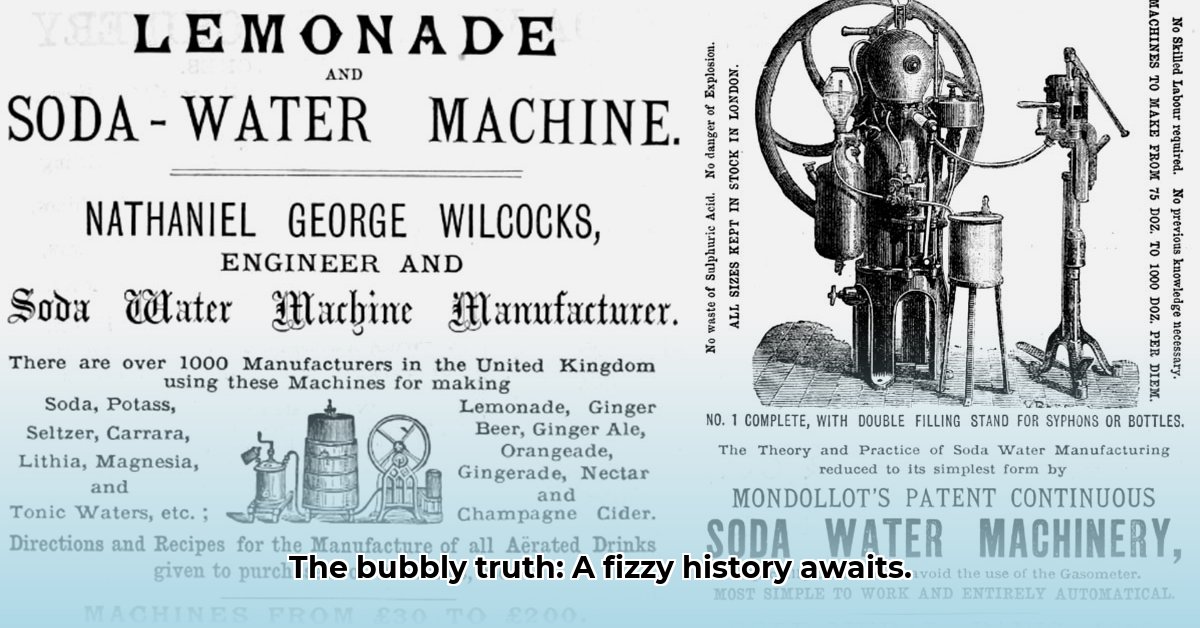
From Healing Springs to Global Phenomenon: A Bubbly Journey Through Time
The story of carbonated beverages is a surprisingly fizzy journey, spanning centuries and continents. It's a tale not just of sugary drinks, but of ingenious inventions, evolving tastes, and unforeseen health consequences. Did you know that the obsession with bubbles started not with sugary sodas, but with a belief in the healing power of naturally carbonated mineral springs? Let's dive into this effervescent history! To learn more about the very first soda, check out this article.
Early civilizations revered naturally carbonated springs, believing their bubbly waters held magical healing properties. People traveled for miles to drink from these sources, associating the fizz with health and vitality. This inherent connection between bubbles and wellbeing laid the foundation for the industry's future. But how did this ancient belief translate into the global phenomenon we know today?
By the 1760s, scientists discovered how to artificially carbonate water—a revolutionary leap! This invention liberated the refreshing fizz from its geographical constraints, making it accessible to a much wider population. Initially marketed as a health elixir, sparkling water offered a refreshing alternative to the often-impure water sources at the time. The perceived health benefits, more than the taste alone, significantly propelled its early adoption. But the story doesn't end there; it's about to get a whole lot tastier.
The Flavor Explosion and the Rise of the Soda Fountain
The addition of flavor marked a pivotal moment in the narrative. Early flavored carbonated drinks often maintained a medicinal bent, incorporating ingredients like ginger and birch bark. Imagine these concoctions as the distant ancestors to modern ginger ale—a testament to the enduring appeal of natural flavors. However, experimentation soon blossomed, leading to an explosion of possibilities in flavor creation.
The 19th century witnessed the rise of the iconic American soda fountain. These ornate marble havens became much more than simple drink dispensaries; they transformed into vibrant social hubs. The satisfying hiss of carbon dioxide as flavored syrups blended with water created a theatrical experience, drawing in customers from all walks of life. Their popularity wasn't just accidental—it was significantly influenced by a significant social movement.
Interestingly, the temperance movement, advocating for alcohol abstinence, unexpectedly propelled the soda fountain's success. This social campaign created a large market for non-alcoholic alternatives to alcoholic beverages, transforming these places into central meeting points for social gatherings. The rise of the soda fountain and its role in social history is a testament to the interplay between social movements and consumer trends.
This era also birthed iconic brands, most notably Coca-Cola. Coca-Cola's masterful marketing transformed a simple carbonated drink into a global phenomenon. The transition from soda fountains to bottled products further democratized access, making fizzy refreshment universally available. This marks a turning point—a shift to a more mass-produced and widely consumed beverage. But did this mass market success come without a price?
Mass Production, Modern Challenges, and the Future of Fizz
The early 20th century witnessed remarkable advancements in bottling and distribution technologies. Carbonated drinks became widely accessible, fueling their integration into popular culture. Aggressive marketing solidified their place in society, yet this widespread success eventually brought about new challenges.
Concerns regarding the high sugar content and potential health consequences began to surface. The once-simple, refreshing beverage found itself thrust into a complex, health-conscious debate. The public perception shifted; what was once a beloved treat was increasingly scrutinized for potential negative impacts on health.
This modern era has witnessed a significant counter-movement. Consumers, increasingly health-conscious, have demanded healthier options. This shifted demand has pushed innovation, driving the creation of low-sugar, sugar-free, and healthier alternatives. Simultaneously, sustainability has become paramount. Companies face growing pressure—both from consumers and legislation—to adopt environmentally friendly practices, from eco-friendly packaging to reduced carbon footprints.
Three Pivotal Points:
- The invention of artificial carbonation revolutionized the accessibility and distribution of carbonated beverages.
- The temperance movement unexpectedly fueled the popularity of soda fountains and non-alcoholic alternatives.
- Modern concerns about sugar content and sustainability are driving innovation toward healthier and more environmentally friendly options.
The journey of carbonated beverages is a fascinating reflection of societal values, technological advancement, and ever-shifting consumer desires. From their beginnings as supposed medicinal elixirs to their current status as everyday staples, their story continues to evolve. The future of fizz remains to be written, a testament to the enduring appeal of a simple, yet remarkably impactful, bubbly drink.